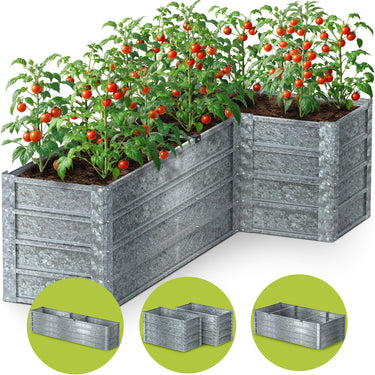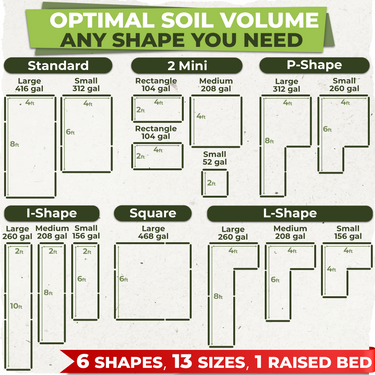
Photo by Shutterstock
Fall gardening is often overlooked by beginners, but it offers unique opportunities for both novice and experienced gardeners. They can yield a variety of vegetables, extend the beauty of your landscape, and even prepare your garden for the following spring. With cooler temperatures, fewer pests, and the prospect of a bountiful harvest just before winter sets in, fall gardening can be immensely rewarding for gardening enthusiasts.
So, if you are a novice gardener, keep in mind that fall gardening can be as enjoyable as any other season. In this regard, you’re probably asking yourself when to start and which are the best plants for a fall garden. This guide will introduce you to the basics of fall gardening, helping you make the most of your garden year-round.
Table of Contents
1. Fall gardening - useful tips for beginners
Fall is a great time to dive into gardening. This season offers a chance to prepare your garden for winter, plant hardy crops, and lay the groundwork for a flourishing spring. With a few helpful tips, you can make the most of your fall gardening experience.
1.1. When to plant a fall garden?
The ideal time to plant a fall garden varies depending on your specific climate and growing zone, but generally, late summer to early fall is the sweet spot for most regions. August and September are often considered the best months to start planting cool-season crops for a late fall harvest. This is also the time when apples, pears, pumpkins, and grapes are picked, celebrated for their rich flavors and vibrant colors. Farmers gather crops like carrots, beets, and potatoes, along with walnuts and chestnuts.
For many gardeners, Labor Day weekend serves as a good reminder to get fall crops in the ground. However, in warmer climates, you might be able to plant well into October. To create the best fall garden planting schedule, consider these key factors:
- Your local first frost date;
- The days to maturity for each crop;
- How cold-hardy each plant is.
Here's a general fall garden planting schedule to use as a starting point:
It's the perfect time to plant leafy greens such as lettuce, spinach, and kale. These cold-tolerant crops can thrive as temperatures begin to drop. This is also an ideal time to start brassicas like broccoli, cauliflower, and cabbage indoors. Starting them early indoors allows them to develop before being transplanted outside in cooler weather.
During this period, it would be ideal to move your brassica seedlings outdoors to your raised garden beds, because the slightly cooler temperatures suit them well. Additionally, this is a great time to plant root vegetables like carrots, beets, and radishes, which grow well in the cool autumn soil and can mature before the frost sets in.
Focus on planting fast-growing greens such as arugula and mustard greens. If you have empty beds in your garden, consider sowing cover crops like clover or rye to protect and enrich the soil for future planting seasons.
As the first frost approaches, plant garlic and onions. These crops will remain dormant through the winter and begin growing in early spring. You can also sow cold-hardy salad greens, such as mache and winter cress.
In the final weeks before frost, plant spring-flowering bulbs like tulips and daffodils. These bulbs benefit from the cooler soil temperatures, allowing them to establish themselves for blooming next year.
Remember to adjust this schedule based on your specific climate and the varieties you're planting. Always check seed packets for specific planting instructions.
1.2. Fall gardening - the best vegetables to plant during the season

Photo by Markus Spiske on Unsplash
Fall gardening offers a wonderful opportunity to extend your growing season and enjoy fresh, homegrown produce well into the cooler months. As temperatures drop and days grow shorter, certain vegetables thrive, offering gardeners a bountiful autumn harvest. So, what to plant in a fall vegetable garden?
Here's a guide to some of the best plants and vegetables to plant in your garden:
-
Leafy greens - lettuce, kale, spinach and swiss chard;
-
Brassicas - broccoli should be planted early in the season for a late fall harvest. Brussels sprouts improve in flavor after a frost. Both green and red cabbage varieties store well for winter use. Cauliflower needs a long growing season, so it's best to plant early for a fall harvest;
-
Root vegetables, such as carrots, beets, radishes and turnips often taste sweeter when grown in cooler weather;
-
Alliums - garlic, onions and leeks;
-
Peas - while often associated with spring, snow peas and sugar snap peas can also be a successful fall crop;
- Hardy herbs - cilantro, parsley, sage and thyme thrive in cooler weather and can withstand light frosts, making them ideal for fall gardens.
When planning your fall garden, consider companion planting to maximize space and improve plant health. For example, carrots and onions grow well together, while brassicas benefit from being planted near aromatic herbs like sage or rosemary, which can help deter pests. Remember to prepare your soil before planting by adding compost or well-rotted manure to replenish nutrients depleted by summer crops.
1.3. Planning a fall garden - essential tools for your gardening arsenal
To successfully cultivate a vibrant fall garden, having the right tools is essential. Without these indispensable instruments, your gardening efforts can quickly become frustrating and inefficient.
From planting to maintenance, the following tools will help you create a bountiful fall garden:

2. Best fall garden crops across the USA: which plants suit your region?
Understanding the climatic zones of your region is crucial for selecting the best fall garden crops that will flourish in your area.
For example, in the Northeastern U.S., with its distinct seasonal changes, brassicas can withstand light frosts, making them ideal for planting in early autumn. Additionally, root vegetables such as carrots, beets, and turnips can be sown late in the summer for harvest in the fall.
The Southeastern U.S. has a warm climate, allowing for a longer growing season that extends into the fall. Here, crops like collard greens, mustard greens, and sweet potatoes thrive as temperatures begin to cool. The region's humidity can be a challenge, so gardeners should be mindful of water management.

Photo by Shutterstock
In the Midwest, characterized by harsh winters, brassicas are among the most successful things to grow in the fall. Gardeners should aim to plant these crops in late summer to allow for sufficient growth before winter sets in.
On the West Coast, where the climate can vary dramatically from coastal regions to deserts, gardeners have a wide array of options for their fall crops. In California’s Central Valley, for instance, the warm autumns allow for the cultivation of crops like garlic and shallots. In the cooler, mountainous areas, the focus should be on crops like winter squash and hardy greens.
Therefore, cultivating a fall garden is not only rewarding, but also a wonderful opportunity to enjoy the unique flavors that the season has to offer. By selecting crops that are well-suited to your specific region, you can optimize your gardening efforts and ensure a bountiful harvest. Whether you're growing kale and spinach or brussels sprouts the key is to embrace the beauty of fall gardening.


































